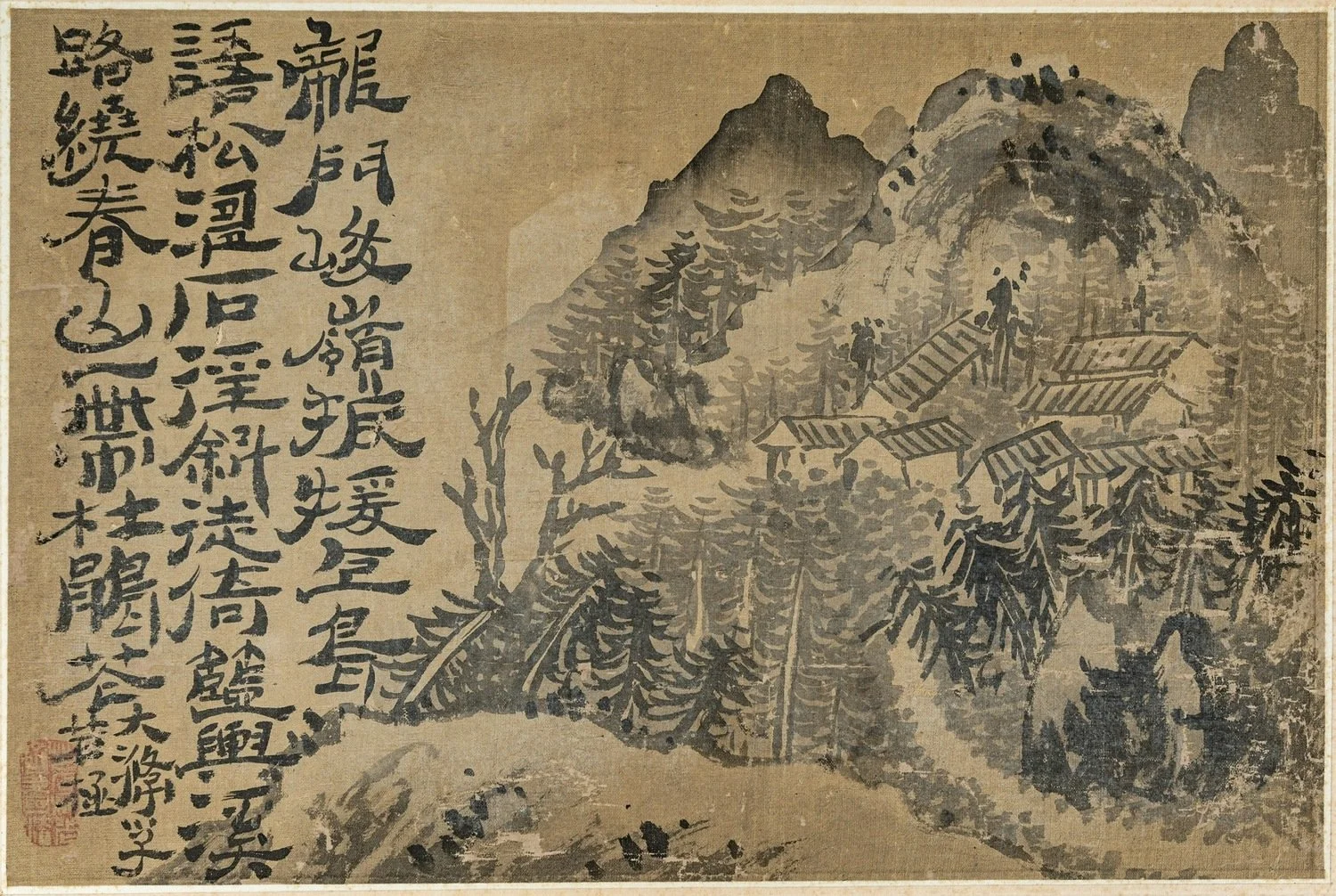About This Artwork
In this work, the distant mountains are rendered with broad, pale ink washes, creating a sense of depth and density. The foreground pines and cypresses are vigorous, like wild cursive script, and the textured strokes—dry and wet, layered and broken—convey both the ruggedness of the rocks and the freedom of splashed-ink expression. The bold composition on the left is anchored by the inscription “Dadizi Ruoji” and the seal “Ku Gua He Shang Ji Hua Fa,” echoing a Chan-inflected notion that “painting has an end, but meaning is boundless.” Shi Tao merges the emptiness of the Southern School with the structural force of the Northern School’s axe-cut strokes, transcending Dong Qichang’s dichotomy through a forceful central-brush technique. His philosophy of “creating method from no method” forms a unique visual language. The painting’s powerful rhythm, integrating calligraphy and image, draws on late Ming expressive traditions while asserting a self-defined path: “I use my own method.” The interplay of ink textures and spatial tension injects new vitality into literati painting and opens a fresh expressive realm rooted in the heart—an artistic declaration against Qing revivalism and a landmark of creative transformation.
• Title: Landscape | 山水
• Year: c. 1690
• Artist: Attributed to Shi Tao | 石涛(款)
• Medium: Ink on silk | 水墨绢本
• Inscription: “Dadizi Ruoji”; Seal: “Ku Gua He Shang Ji Hua Fa” | 款识:大滌子若極;钤印:「苦瓜和尚濟畫法」
• Dimensions: 24 x 35.5 cm
• Framed Dimensions: 53.5 x 91 x 5 cm
* This is the original, one-of-a-kind artwork created by the artist, not a reproduction or print. It carries the full authenticity and intention of the artist’s hand.
About the Artist
Shi Tao (1642–1707) was a painter of the late Ming and early Qing period. Born Zhu Ruoji, a descendant of the imperial family, he became a monk under the name Shitao and also referred to himself as the "Bitter Melon Monk." His life was marked by travel and reclusion; he explored famous mountains and emphasized expressive individuality in painting. Advocating that "brush and ink must follow the times," he developed a distinctive style in the early Qing art scene. His landscapes are known for their dynamic compositions, bold brushwork, and calligraphic energy. His Sayings on Painting by the Bitter Melon Monk established his position as a painting theorist, and his influence has been far-reaching. As one of the “Four Monks” of early Qing painting, alongside Bada Shanren, he is regarded as one of the most innovative figures in the history of Chinese art, channeling the trauma of dynastic change into a personal and spiritual visual language.
About This Artwork
In this work, the distant mountains are rendered with broad, pale ink washes, creating a sense of depth and density. The foreground pines and cypresses are vigorous, like wild cursive script, and the textured strokes—dry and wet, layered and broken—convey both the ruggedness of the rocks and the freedom of splashed-ink expression. The bold composition on the left is anchored by the inscription “Dadizi Ruoji” and the seal “Ku Gua He Shang Ji Hua Fa,” echoing a Chan-inflected notion that “painting has an end, but meaning is boundless.” Shi Tao merges the emptiness of the Southern School with the structural force of the Northern School’s axe-cut strokes, transcending Dong Qichang’s dichotomy through a forceful central-brush technique. His philosophy of “creating method from no method” forms a unique visual language. The painting’s powerful rhythm, integrating calligraphy and image, draws on late Ming expressive traditions while asserting a self-defined path: “I use my own method.” The interplay of ink textures and spatial tension injects new vitality into literati painting and opens a fresh expressive realm rooted in the heart—an artistic declaration against Qing revivalism and a landmark of creative transformation.
• Title: Landscape | 山水
• Year: c. 1690
• Artist: Attributed to Shi Tao | 石涛(款)
• Medium: Ink on silk | 水墨绢本
• Inscription: “Dadizi Ruoji”; Seal: “Ku Gua He Shang Ji Hua Fa” | 款识:大滌子若極;钤印:「苦瓜和尚濟畫法」
• Dimensions: 24 x 35.5 cm
• Framed Dimensions: 53.5 x 91 x 5 cm
* This is the original, one-of-a-kind artwork created by the artist, not a reproduction or print. It carries the full authenticity and intention of the artist’s hand.
About the Artist
Shi Tao (1642–1707) was a painter of the late Ming and early Qing period. Born Zhu Ruoji, a descendant of the imperial family, he became a monk under the name Shitao and also referred to himself as the "Bitter Melon Monk." His life was marked by travel and reclusion; he explored famous mountains and emphasized expressive individuality in painting. Advocating that "brush and ink must follow the times," he developed a distinctive style in the early Qing art scene. His landscapes are known for their dynamic compositions, bold brushwork, and calligraphic energy. His Sayings on Painting by the Bitter Melon Monk established his position as a painting theorist, and his influence has been far-reaching. As one of the “Four Monks” of early Qing painting, alongside Bada Shanren, he is regarded as one of the most innovative figures in the history of Chinese art, channeling the trauma of dynastic change into a personal and spiritual visual language.

